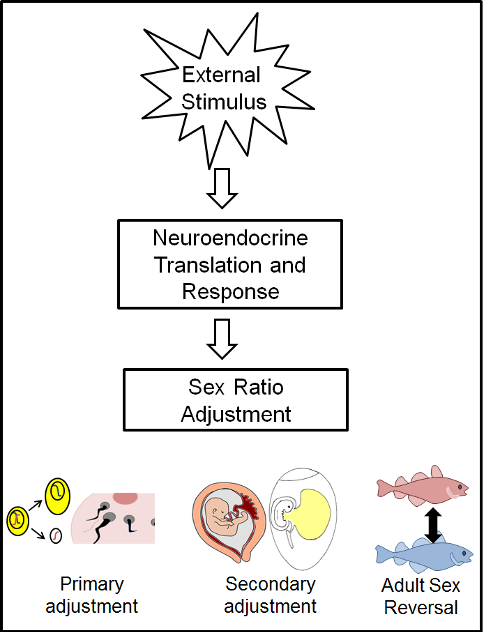SICB Annual Meeting 2013
January 3-7, 2013
San Francisco, CA
Symposium: Hormone-mediated sex ratio adjustment in vertebrates
 The sex ratio of a population is a major determinant of the population’s survival and the reproductive success of individuals within the population. The ability of an individual to adjust the sex ratios of the offspring they produce, or to change their sex at the adult level such that the number of males and females at the population level are influenced, is a powerful concept and one that has been discussed in an evolutionary context for decades. Although for some systems, such as reptiles and some fishes, the mechanisms by which sex can be altered through environmental cues have been addressed in detail, in other systems, such as birds and mammals, surprisingly little is known about the mechanisms of sex ratio adjustment. There is increasing support for the idea that hormones lie at the mechanistic center of sex ratio adjustment in a majority of vertebrate systems, however there is very little crosstalk among researchers studying sex ratio adjustment in various vertebrate classes. While mechanisms of sex determination differ among these systems, there appears to be a conservation of the ability for hormones to translate external stimuli into sex ratio skews. The possibilities become even more dynamic when including systems that utilize non-genomic mechanisms of sex ratio adjustment, such as birds and fish.
The sex ratio of a population is a major determinant of the population’s survival and the reproductive success of individuals within the population. The ability of an individual to adjust the sex ratios of the offspring they produce, or to change their sex at the adult level such that the number of males and females at the population level are influenced, is a powerful concept and one that has been discussed in an evolutionary context for decades. Although for some systems, such as reptiles and some fishes, the mechanisms by which sex can be altered through environmental cues have been addressed in detail, in other systems, such as birds and mammals, surprisingly little is known about the mechanisms of sex ratio adjustment. There is increasing support for the idea that hormones lie at the mechanistic center of sex ratio adjustment in a majority of vertebrate systems, however there is very little crosstalk among researchers studying sex ratio adjustment in various vertebrate classes. While mechanisms of sex determination differ among these systems, there appears to be a conservation of the ability for hormones to translate external stimuli into sex ratio skews. The possibilities become even more dynamic when including systems that utilize non-genomic mechanisms of sex ratio adjustment, such as birds and fish.
Objective:
This symposium will bring together researchers studying hormonal mechanisms of sex adjustment in birds, reptiles, fishes, humans, and non-human mammals in an effort to stimulate new research avenues in the study of sex ratio adjustment. By demonstrating novel approaches in their own vertebrate systems used to address similar questions about sex ratio adjustment, we will encourage cross-fertilization of ideas among speakers and introduce researchers interested in maternal effects to potential research avenues to which their current research in their respective systems could prove applicable.
Sponsors: SICB Divisions of Comparative Endocrinology, Comparative Physiology and Biochemistry, and Animal Behavior
National Science Foundation (pending)
Organizer
- Kristen Navara (University of Georgia)
Speakers
S5-1.1 Saturday, Jan. 5, 08:00 CREWS, D:
Targets for hormone-mediated sex ratio adjustment in vertebrates
S5-1.2 Saturday, Jan. 5, 08:30 BOWDEN, R.M.*; CLAIRARDIN, S.G.; PAITZ, R.T.:
Early hormonal influences on temperature dependent sex determination in turtles
S5-1.3 Saturday, Jan. 5, 09:00 NAVARA, KJ:
Stress, hormones, and sex: How do we solve the puzzle of sex ratio adjustment in birds?
S5-1.4 Saturday, Jan. 5, 09:30 GROOTHUIS, T.G.G.*; GOERLICH, V.C.; DIJKSTRA, C.:
The role of maternal hormones in avian sex ratio manipulation
S5-1.5 Saturday, Jan. 5, 10:30 BADYAEV, A.V.:
From emergence to evolution: Phenotypic integration of complex offspring sex-bias
S5-2.1 Saturday, Jan. 5, 13:30 NAGAHAMA, Y.:
Genetic and hormonal regulation of gonadal development and sexual plasticity in fish
S5-2.2 Saturday, Jan. 5, 14:00 MARUSKA, K.P.*; FERNALD, R.D.:
Social regulation of male reproductive plasticity in an African cichlid fish
S5-2.3 Saturday, Jan. 5, 14:30 GODWIN, J*; SLANE, MA; GEMMELL, NJ:

